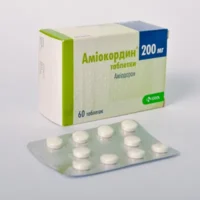Description
Amlodipine Tablets 10 mg. №20
Composition
Each tablet contains 10 mg of Amlodipine besylate.
Mechanism of Action
Amlodipine is a calcium channel blocker that works by relaxing blood vessels, facilitating easier blood pumping by the heart, and reducing blood pressure levels.
Pharmacological Properties
Amlodipine exerts its antihypertensive effects by inhibiting the influx of calcium ions into vascular smooth muscle cells, leading to vasodilation and decreased peripheral resistance.
Indications for Use
Amlodipine tablets are indicated for the treatment of hypertension (high blood pressure) and variant angina (Prinzmetal or vasospastic angina).
Contraindications
Do not use Amlodipine if you are allergic to amlodipine or any other component of the formulation. Avoid in patients with severe coronary artery disease or those with a history of significant hypotension.
Side Effects
Common side effects of Amlodipine may include peripheral edema (swelling in the ankles or feet), dizziness, flushing, and headache. Severe side effects are rare but may include hypotension and allergic reactions.
Usage Instructions
The recommended dosage of Amlodipine is one 10 mg tablet per day, with or without food. Swallow the tablet whole with a glass of water. Do not crush or chew the tablet.
Benefits Compared to Analogues
Amlodipine is preferred over other antihypertensive medications due to its once-daily dosing convenience, efficacy in lowering blood pressure, and well-established safety profile.
Suitable Patient Groups
Amlodipine is suitable for adult patients with hypertension or angina, including elderly individuals. It is not recommended for use in children under the age of 6 years.
Storage and Shelf Life
Store Amlodipine tablets at room temperature away from moisture and heat. Keep the medication in its original packaging to protect from light. Check the expiration date and do not use after the stated shelf life.
Packaging Description
Amlodipine tablets are typically packaged in blister packs of 20 tablets each. The packaging is designed to ensure the stability and integrity of the tablets until use.
Clinical Evidence and Proven Effectiveness
Clinical studies have shown that Amlodipine effectively reduces both systolic and diastolic blood pressure levels. Research published in the American Journal of Hypertension demonstrated that Amlodipine is well-tolerated and significantly reduces blood pressure in hypertensive patients, thereby reducing the risk of cardiovascular events.
Additional Information
Regular monitoring of blood pressure is essential during Amlodipine therapy to optimize treatment outcomes. Patients should report any persistent or worsening side effects to their healthcare provider. Prior to starting Amlodipine, inform your doctor about all existing medical conditions and concomitant medications to prevent potential drug interactions.





